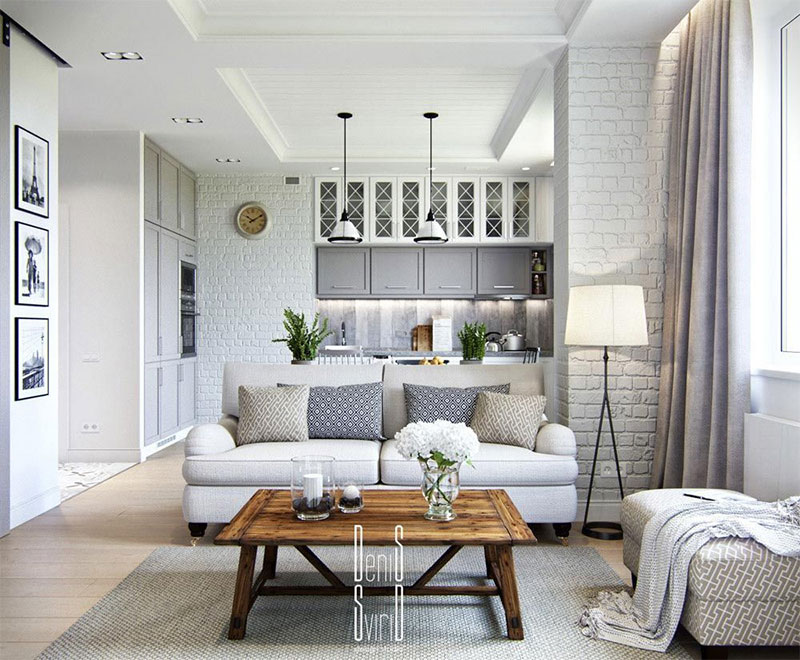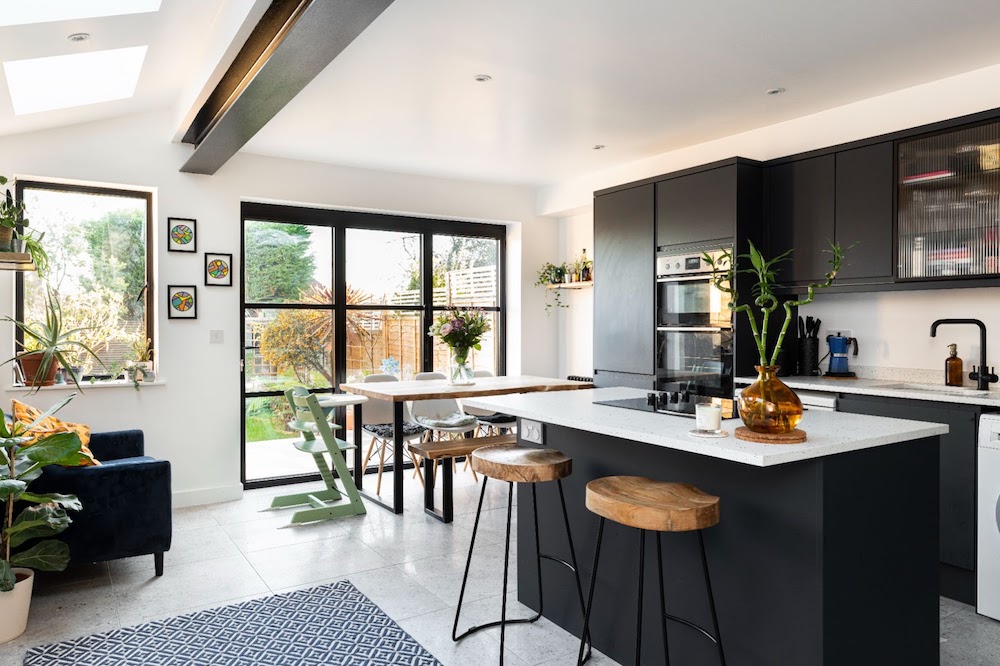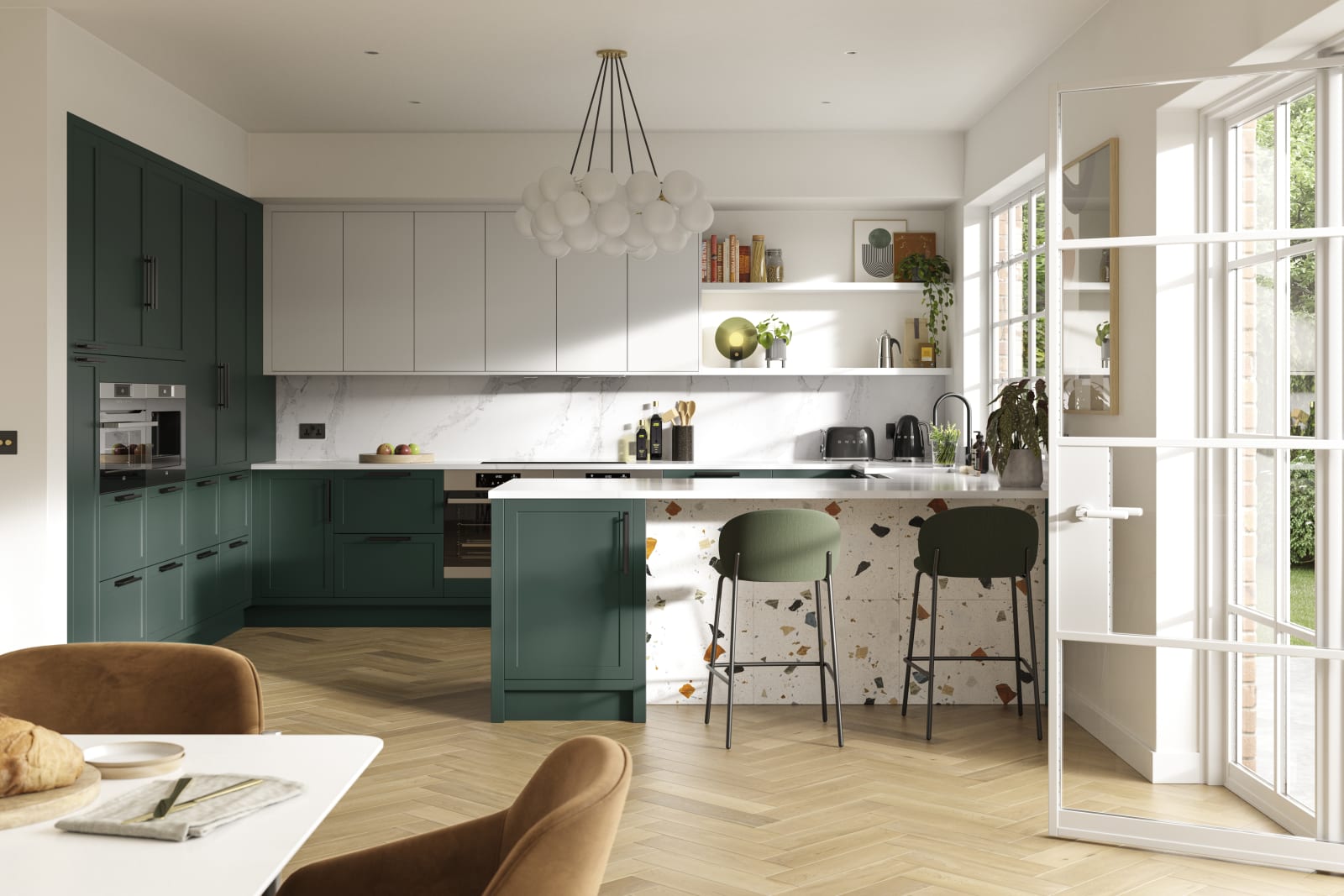Kitchen & Living Room Harmony: Design Ideas That Wow

Kitchen & Living Room Harmony: Design Ideas That Wow
The open-plan concept has revolutionized home design, blurring the lines between the kitchen and living room. This creates a dynamic and inviting space, perfect for entertaining, cooking, and simply relaxing. But achieving that perfect balance between functionality and aesthetic appeal can be a challenge. Fear not, as this comprehensive guide will explore a plethora of kitchen and living room design ideas to transform your space into a harmonious masterpiece.
1. Embrace the Flow

The key to a seamless open-plan design lies in establishing a fluid flow. Imagine a graceful dance between the kitchen and living room, where movement feels effortless and the spaces complement each other. This starts with strategically planning your layout:
- Open Concept: An Ode to Functionality: An open concept layout maximizes space and encourages interaction between areas. Consider kitchen islands as a focal point, offering extra counter space and seating.
- Strategic Zoning: Define distinct areas within the open plan using rugs, lighting, and furniture arrangements. This helps create a sense of separation without sacrificing the open feel.
- Traffic Flow: Ensure pathways are unobstructed, allowing easy movement between the kitchen and living room. Avoid placing furniture or appliances in high-traffic areas.
2. A Symphony of Colors and Textures
Choosing the right color palette and textures for your kitchen and living room is crucial for establishing a cohesive and aesthetically pleasing ambiance.
- Complementary Color Schemes: Experiment with contrasting shades that complement each other. A bold kitchen backsplash can beautifully echo a vibrant accent wall in the living room.
- Monotone Magic: Embrace the elegance of a monotone color scheme. Choose various shades of the same color, using light tones for the kitchen and darker tones for the living room to add depth and visual interest.
- Texture Play: Introduce different textures to add visual interest and tactile appeal. Combine smooth countertops with woven rugs, glossy cabinets with velvety upholstery, and rough-hewn wood with metallic accents.
3. Lighting: Illuminating the Mood
:max_bytes(150000):strip_icc()/rsw1968h1312-4eaece4f34b8459a8ac8d9df12fc53fa.jpeg)
Lighting plays a pivotal role in setting the tone of your open-plan space. Strategic lighting design can emphasize specific features, create cozy nooks, and enhance the overall ambiance.
- Layered Lighting: Achieve optimal illumination and versatility by combining different types of lighting. Recessed lighting provides general illumination, pendant lights over the kitchen island add a touch of style, and table lamps in the living room create a warm, inviting glow.
- Dimmable Lighting: Embrace dimmable lighting for versatility. This allows you to adjust the mood from bright and functional to cozy and intimate.
- Highlighting Focal Points: Use strategically placed spotlights to highlight beautiful features like a statement chandelier or a unique artwork.
4. Furniture Fusion: A Stylish Blend
The furniture you choose for your open-plan space should complement the existing design and create a unified aesthetic.
- Multifunctional Furniture: Embrace furniture with dual purposes. Choose a sofa with storage for added practicality or an ottoman that doubles as a coffee table.
- Consistent Style: Maintaining a consistent design style across both areas is key. Modern kitchen chairs can seamlessly transition into a contemporary living room sofa while rustic dining tables pair well with farmhouse-style living room furniture.
- Seating Solutions: Ensure adequate seating in both areas to accommodate various activities. Consider incorporating bar stools at the kitchen island for casual dining and comfortable armchairs in the living room for reading or conversation.
5. The Art of Decoration: Finishing Touches

Decorative elements provide the finishing touch to your open-plan design, adding personality and visual interest.
- Wall Art: Use wall art to unify the spaces and create a cohesive look. A gallery wall showcasing family photos or artwork in a consistent color palette creates a seamless transition between the kitchen and living room.
- Curtains and Textiles: Window treatments can tie the spaces together. Consider using matching curtains in both areas or using different textures to create visual interest.
- Plants and Greenery: Incorporate greenery to bring life and fresh energy into the space. Potted plants on shelves or hanging baskets create a visual appeal and add a touch of nature.
6. Kitchen Design Considerations

The kitchen is the heart of your open-plan space, requiring careful planning and design decisions to ensure functionality and aesthetic appeal.
- Countertop Space: Ample countertop space is essential for food preparation, dining, and entertaining. Consider incorporating a large kitchen island or extended countertops for added space.
- Storage Solutions: Maximize storage space to keep your kitchen organized and clutter-free. Cabinetry with pull-out drawers, open shelving for display, and built-in appliances can all contribute to efficient storage.
- Appliance Choice: Choose appliances that complement the overall style of your kitchen and living room. Consider sleek stainless steel for a modern feel or black matte appliances for a contemporary vibe.
7. Living Room Design Considerations
The living room should provide a welcoming and relaxing atmosphere while harmonizing with the kitchen design.
- Focal Point: Create a focal point in the living room to draw attention and define the space. A fireplace, a statement rug, or a large piece of artwork can all serve as focal points.
- Comfort and Functionality: Choose comfortable seating arrangements that suit your lifestyle and encourage relaxation. Consider incorporating a sectional sofa, armchairs, and ottomans for added comfort and functionality.
- Entertainment Options: Include features that enhance your entertainment experience, such as a TV mounted on the wall, a home theater system, or a built-in bookcase.
8. Open-Plan Kitchen & Living Room Design Tips

Here are some additional tips to ensure success with your open-plan kitchen and living room design:
- Consider the Scale: Ensure that the furniture and decor in both areas are appropriately scaled to avoid overwhelming the space.
- Think About Acoustics: Open-plan spaces can amplify sound. Use acoustic panels, rugs, and soft furnishings to absorb sound and create a more comfortable ambiance.
- Prioritize Natural Light: Maximize natural light by installing large windows and using light-colored paint and furniture. This creates a bright and welcoming atmosphere.
- Don't Overcrowd: Resist the urge to fill the space with too much furniture. Leave enough space for movement and create a sense of openness and airiness.
- Be Flexible: Remember that your needs and preferences may change over time. Choose design elements that are adaptable and can be easily rearranged as your lifestyle evolves.
- Seek Professional Guidance: If you're feeling overwhelmed, consider consulting a professional interior designer. They can provide expert advice and create a cohesive and stunning open-plan design tailored to your needs.
Conclusion

Creating a harmonious kitchen and living room is a rewarding and transformative project. By embracing the ideas presented in this guide, you can transform your space into a functional and stylish haven that reflects your personal style and enhances your daily life. Remember, the key lies in careful planning, a cohesive design approach, and a touch of creativity.
Kitchen & Living Room: One Space, Endless Style
The heart of a home is often a space that serves dual purposes, seamlessly merging the functionality of a kitchen with the comfort of a living room. This open concept design, known as a kitchen-living room combination, has become increasingly popular, offering a harmonious blend of practicality and aesthetics. This dynamic space invites both culinary creations and cherished gatherings, creating an inviting and functional environment for everyday living.
This article explores the captivating world of kitchen-living room combinations, offering a comprehensive guide to design, layout, and decor, empowering you to transform your space into a masterpiece of style and functionality.
The Allure of Open Concept:
The rise of open concept living has revolutionized home design, blurring the lines between traditional rooms. This layout fosters a sense of openness and spaciousness, allowing natural light to flow freely and maximizing the feeling of airiness. It's a design philosophy that celebrates the interconnectedness of living, encouraging interaction and fostering a sense of community within the home.
Benefits of a Kitchen-Living Room Combination:
- Enhanced Space: This design optimizes space utilization, making smaller homes feel larger and maximizing square footage.
- Social Connection: It promotes interaction, creating a central gathering space for families and friends.
- Increased Natural Light: Open layouts allow natural light to flood the space, creating a bright and inviting atmosphere.
- Flexibility: The open plan allows for adaptable furniture arrangements and reconfigurations to suit different needs and occasions.
Design Considerations for Your Kitchen-Living Room Combination:
1. The Flow of Your Space:
-
Defining Zones: While seamlessly blending the two spaces, it's crucial to visually delineate separate zones. This can be achieved through strategic use of materials, flooring, colors, and furniture placement.
-
Traffic Flow: Plan the layout to ensure smooth and efficient movement between the kitchen, dining, and living areas, avoiding bottlenecks and ensuring a comfortable flow.
2. A Unified Design Palette:
-
Color Harmony: Employ a cohesive color palette across both areas to create a sense of unity and visual appeal. Choose a dominant neutral color, like gray or beige, and introduce pops of accent colors through furniture, artwork, and accessories.
-
Material Continuity: Consider using similar materials throughout, such as wood flooring, granite countertops, or stainless steel accents. This creates a sense of cohesiveness while allowing for subtle variations in texture and finish.
3. Visual Separation Strategies:
-
Furniture Placement: Strategic furniture arrangements can subtly define zones. Place a sofa or a large rug to anchor the living area, while an island or a dining table can serve as a visual separator for the kitchen.
-
Height Variations: Consider incorporating different ceiling heights in the kitchen and living room to create a sense of separation.
-
Open Shelving: Utilizing open shelving in the kitchen can add visual interest and define a zone without creating a sense of enclosure.
-
Room Dividers: Strategically placed room dividers, such as bookshelves, decorative screens, or even a curtain, can visually divide the spaces while maintaining an open feel.
4. The Power of Lighting:
-
Layered Lighting: Create a dynamic and inviting atmosphere with layered lighting. Incorporate ambient lighting for general illumination, task lighting for specific areas like the kitchen counter or reading nook, and accent lighting to highlight artwork or architectural features.
-
Dimmable Options: Choose dimmable lights for flexibility and control over the mood of the space, adjusting the lighting to suit different activities and times of day.
5. Choosing the Right Furniture:
-
Multifunctional Pieces: Select furniture with dual functionality to maximize space and offer versatility. For example, choose a sofa with built-in storage, or a coffee table that doubles as a dining table.
-
Scale and Proportion: Ensure that furniture pieces are proportionate to the size of the space. Overcrowding can create a cramped feel, while oversized furniture can make the room feel smaller.
-
Comfort and Style: Choose comfortable seating options in the living area, like plush sofas, comfy armchairs, and cozy ottomans. Consider materials that complement the overall design aesthetic.
6. Accessorizing with Style:
-
Art and Decor: Add personality to your open concept space through artwork, sculptures, plants, and decorative accessories. Consider incorporating artwork that complements the color palette and design style.
-
Textiles and Rugs: Use textiles and rugs to add warmth, texture, and visual interest to the space. A statement rug can define the living area and enhance the overall aesthetic.
-
Storage Solutions: Maximize storage in both the kitchen and living room to keep the space organized and clutter-free. Consider using shelves, cabinets, baskets, and other creative storage solutions.
Kitchen Design Considerations:
1. Functional Layout:
-
Work Triangle: Maintain an efficient work triangle in the kitchen, connecting the stovetop, sink, and refrigerator. This layout ensures smooth movement and a well-organized workflow.
-
Island or Peninsula: Incorporate an island or peninsula for extra counter space, additional seating, and a central focal point.
-
Storage Solutions: Maximize storage in the kitchen with cabinetry, drawers, and other solutions to keep your belongings organized and accessible.
2. Choosing Appliances:
- Style and Functionality: Select appliances that complement the design aesthetic and meet your specific needs. Consider energy-efficient options for sustainability and cost savings.

- Stainless Steel or Black: Stainless steel appliances offer a sleek and modern look, while black appliances can provide a dramatic and elegant feel.
3. Countertop Materials:
- Durability and Style: Choose durable countertop materials like granite, quartz, or laminate that can withstand everyday use.

- Seamless Flow: Consider using the same countertop material in the kitchen and a coordinating countertop for the island or peninsula to create a cohesive look.
4. Backsplash Options:
- Visual Interest: Add visual interest to the kitchen with a stylish backsplash. Choose from a variety of materials, including tile, glass, metal, and stone.
- Cohesive Design: Select a backsplash that complements the countertop and cabinet choices, creating a harmonious and cohesive design.
Living Room Design Considerations:
1. Focal Point:
:max_bytes(150000):strip_icc()/rsw1968h1312-4eaece4f34b8459a8ac8d9df12fc53fa.jpeg)
-
Fireplace: A fireplace can be a striking focal point for the living room, adding warmth and ambiance.
-
Entertainment Center: A well-designed entertainment center can serve as a focal point for the living room, housing a TV, sound system, and other electronics.
-
Statement Furniture: A statement sofa, armchair, or rug can create a focal point and define the living room space.

2. Seating Options:
-
Comfort and Style: Choose comfortable seating options for relaxing and entertaining. Consider a combination of sofas, armchairs, ottomans, and bean bags to create a welcoming environment.
-
Versatility: Select seating options that can be rearranged to suit different occasions and gatherings.

3. Decorative Touches:
-
Wall Decor: Add personality to the living room with wall decor, such as artwork, photographs, mirrors, and wall shelves.
-
Textiles and Rugs: Use textiles and rugs to add warmth, texture, and visual interest to the living room.

- Plants and Accessories: Incorporate plants and decorative accessories to add pops of color, texture, and personality to the space.
4. Lighting Considerations:
- Ambient Lighting: Provide general illumination with overhead lighting or floor lamps.
-
Task Lighting: Use task lighting for reading or other activities that require focused light.
-
Accent Lighting: Highlight artwork or architectural features with accent lighting.
Tips for Creating a Seamless Blend:

- Choose a unifying theme: Select a design theme, such as modern, farmhouse, minimalist, or eclectic, to create a cohesive look throughout the combined space.
- Highlight architectural features: Draw attention to existing architectural features, such as vaulted ceilings, exposed beams, or brick walls, to create a sense of character and visual interest.
- Embrace open shelving: Incorporate open shelving in the kitchen to break up the wall and create a more open feel, while also providing a decorative display for dishes, glasses, and other items.
- Use a rug to define zones: A large rug can visually separate the kitchen and living room areas, creating distinct zones while maintaining a sense of continuity.
- Utilize consistent materials: Repeat materials throughout the space, such as wood flooring, granite countertops, or stainless steel accents, to create a unified and cohesive look.
- Introduce natural elements: Bring in natural elements like plants, wood, or stone to create a sense of warmth and tranquility in the space.
Conclusion:
A kitchen-living room combination offers endless possibilities for creating a stylish and functional space that seamlessly blends the practicality of a kitchen with the comfort of a living room. By carefully considering design elements, incorporating a cohesive color palette, and utilizing strategic furniture arrangements, you can transform your space into a masterpiece of both aesthetics and functionality.

Embrace the flow of this dynamic space, inviting culinary creations and cherished gatherings to flourish within the heart of your home. With a little planning and creativity, you can create a kitchen-living room combination that is both beautiful and functional, a space where life's most cherished moments unfold. .

